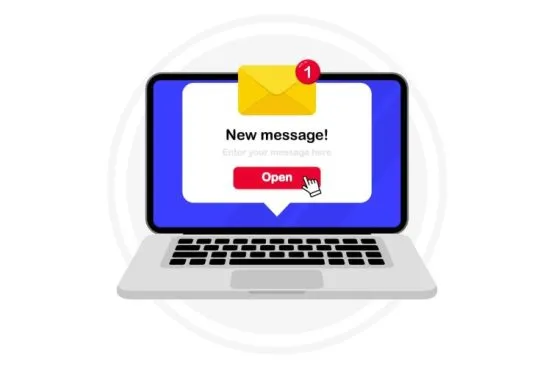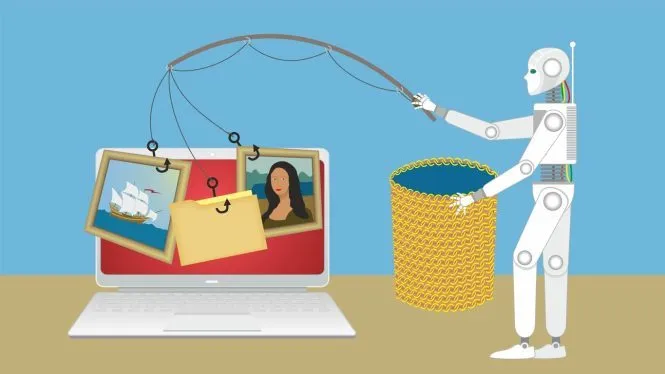What is Email Phishing?
Email phishing is a form of deceptive cyber attack. The attacker uses email to impersonate a legitimate entity, such as a bank, to deceive the victim into clicking on a harmful link, downloading malware, or providing sensitive information.
Here’s how it works: imagine you get an email that looks like it’s from your bank. The logo, the fonts, everything seems legit. The email might warn you about suspicious activity on your account, or offer a chance to win a free prize (because who wouldn’t want that, right?).
The goal? To trick you into clicking a malicious link or opening an attachment. These can download nasty malware onto your device, or take you to a fake website designed to steal your personal information like passwords or credit card details.
Think of it as a digital fishing lure – cybercriminals cast out these emails hoping to catch someone unaware. Here’s the scary part: these phishing emails can be very convincing. They might even use your real name, or mimic the language and style of real emails from your bank or other trusted companies.
A Brief History of Phishing
Phishing scams might seem like a new invention, but they’ve actually been around since the Wild West days of the internet – yes, we’re talking the 1990s and those clunky AOL email accounts!
Back then, inboxes were flooded with these deceptive emails, trying to trick users out of their personal information. As the internet revolutionized how we communicate and shop, so did phishing scams.
Today, with online banking, shopping carts overflowing with digital goodies, and subscriptions galore, cybercriminals have a feeding frenzy of potential victims. Imagine a bottomless pool of people using the internet – that’s the target for these scams.
What makes phishing so dangerous? It preys on two very human tendencies: trust and habit. We often trust familiar brands and logos, making a cleverly designed phishing email seem like the real deal.
Plus, with so much online shopping requiring us to enter personal details, clicking on a link or filling out a form in a phishing email might not seem out of the ordinary. But that’s exactly what the scammers are counting on!
Here’s the dark secret of phishing: it only takes one person to fall for the scam for the criminals to win. They can send out mass emails, and with a vast pool of potential victims online, even a small success rate means big profits for them.
11 Common Types of Email Phishing
Phishing attacks come in many flavors, each designed to trick you in a different way:

-
Spear Phishing:
This is a targeted attack where the email seems personalized. Imagine getting an email that mentions your name, job title, and even references your company. It might appear to be from a colleague or someone within your organization, making it even more believable.
-
Whaling:
Whaling: Think bigger fish. Whaling attacks target high-level executives like CEOs or CFOs. These emails can be especially dangerous because of the potential access these individuals have within a company.
-
Email Spoofing:
This is the most common type of phishing. Cybercriminals “spoof” a legitimate sender’s email address, making it appear like the email is from your bank, credit card company, or another trusted source. Be a detective – look closely at the sender’s email address for any typos or strange characters.
-
Content Engineering:
These emails play on our emotions. They might create a sense of urgency by threatening to close your account if you don’t “verify” your information immediately. On the flip side, they might offer tempting rewards to lure you in.
-
Fake Attachments:
Beware of those seemingly harmless attachments! These emails might trick you into downloading a document that actually installs malware on your device.
-
Pretext Phishing:
This type of attack weaves a story to gain your trust. For example, the email might impersonate IT support, claiming to fix a nonexistent technical issue and requesting remote access to your device.
-
Smishing and Vishing:
These attacks use SMS text messages (smishing) or voice calls (vishing) instead of email to impersonate legitimate entities and try to trick you into revealing personal information or clicking on malicious links.
-
Angler Phishing:
This tactic involves directing users to fake websites that look like real ones. Attackers might use social media posts or online ads to trick you into clicking on a link that leads to a phishing website.
-
Evil Twin Phishing:
This attack involves creating a fake Wi-Fi network with a name that closely resembles a legitimate network (e.g., “Free Airport WiFi” or “Coffee Shop Guest”). When users connect to the fake network, cybercriminals can potentially steal their data.
-
Watering Hole Phishing:
In this attack, attackers target websites that a specific group of people are likely to visit. They inject malicious code into the website, and when those users visit the compromised site, they become vulnerable to phishing attacks.
-
Pharming:
This attack involves redirecting users to a fake website even if they type in the correct address. Attackers achieve this by manipulating DNS records (Domain Name System) which translate website names into IP addresses.
How to Protect Yourself from Phishing
Phishing attacks can feel like a digital fishing expedition – cybercriminals cast out deceptive emails hoping to reel you in. Unlike other cyberattacks, there’s no magic software shield – avoiding phishing scams relies on your vigilance.
But fear not, here are some tips to help you steer clear:
-
•
Be Wary of Unsolicited Emails:
Be wary of unsolicited emails, especially those with tempting offers or urgent warnings. Treat them like strangers on the internet – don’t click on links or download attachments unless you’re absolutely sure they’re safe.
-
•
Verify the Sender's Addresses:
Check the Sender’s ID (Twice!). Don’t be fooled by familiar logos or names. Always double-check the sender’s email address. Legitimate companies will use a custom domain that matches their website (e.g., bankname.com, not b4nkname.com).
-
•
Don't Be Pressured by Urgency:
Phishing emails often create a sense of urgency, pressuring you to act immediately. Remember, legitimate companies won’t threaten to close your account or demand immediate action via email. If something feels off, take a step back.
-
•
Hover Before You Click:
Most email clients let you see the actual target URL when you hover your mouse over a link. Don’t click blindly – make sure the URL matches what you expect before clicking anywhere.
-
•
Go Straight to the Source:
If an email claims there’s an issue with your account, log in directly to the website (don’t click any links in the email) and check for any notifications there. This way, you’re going straight to the source and avoiding any potential phishing traps.
-
•
Spot the Phishing Lures:
Familiarize yourself with common phishing email tactics. Emails with subject lines like “Urgent Action Required: Verify Your Bank Account” or “Congratulations! You’ve Won a Free Gift Card!” are giant red flags. Professional companies don’t use scare tactics or outlandish promises.
How Phishing is Evolving with AI

Phishing scams used to be like those old, clunky fishing rods – easy to spot and even easier to avoid. But with Artificial Intelligence (AI) in the picture, cybercriminals are casting a much more sophisticated net.
Let’s dive into how AI is making phishing a whole new beast,
-
•
Sophisticated Email Generation:
- Natural Language Processing (NLP): AI can write emails that sound like they came straight from your boss or bank. Say goodbye to typos and hello to perfectly crafted sentences designed to trick you.
- Personalization: Ever feel like that phishing email knew a little too much about you? Thank AI for that. It can analyze your online behavior to personalize emails, making them even more believable.
-
•
Enhanced Social Engineering:
- Social Media Data Mining: AI can crawl through social media like a sneaky data detective, picking up bits of information to use in phishing attacks. Creepy, right?
- Deepfakes: Imagine getting a video call from your CEO (who is actually an AI-generated fake) asking for your password. That’s the power (and danger) of deepfakes in phishing.
-
•
Automated Phishing
- Phishing on Autopilot: AI can automate spear phishing emails, sending out personalized messages to specific targets like clockwork.
- Phishing Kits for Everyone: Less tech-savvy criminals can now buy AI-powered phishing kits on the dark web, making it easier for them to launch sophisticated attacks.
-
•
AI-Driven Bait and Hook Techniques
- Dynamic Content: AI can create dynamic phishing content that changes based on the user’s interactions, making it more convincing and harder to detect by traditional security measures.
- Real-Time Engagement: AI chatbots can engage with victims in real time, answering questions and guiding them through the phishing process to extract sensitive information.
-
•
Bypassing Security Measures
AI can help develop phishing techniques that slip past traditional defenses like spam filters. Think of it as the ultimate game of cat and mouse.
-
•
Evolving Malware
AI can create malware that changes its code constantly, making it harder for antivirus software to detect.
-
•
Phishing as a Service (PhaaS)
Scam at Scale: AI can automate phishing operations, allowing criminals to target a massive number of people with minimal effort.
Countermeasures and Defense Strategies:
AI is both enhancing the sophistication of phishing attacks and providing new tools for defense. Staying ahead in this cat-and-mouse game requires leveraging AI for robust cybersecurity measures and continuous user education.
Here are few ways to counteract AI-fueled phishing attempts:
-
•
AI-Powered Detection
Leveraging AI to detect and respond to phishing attempts by analyzing patterns and behaviors indicative of phishing.
-
•
User Education
Continuous education and awareness training for users to recognize and avoid phishing attempts.
-
•
Multi-Factor Authentication (MFA)
Implementing MFA to add an extra layer of security, making it harder for attackers to gain access even if credentials are compromised.
-
•
Advanced Threat Intelligence
Using AI to gather and analyze threat intelligence, predicting and mitigating phishing threats proactively.




